Living room interior in gray tones

The living room is a significant place in any home. Here not only the inhabitants spend a lot of time, but also receive guests. This place must be cozy, stylish, elegant and beautiful at the same time. If you like creative solutions, try decorating the living room in a strict and status gray scale.
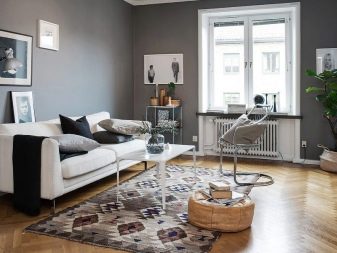

Advantages
The interior of the living room, hall in gray tones is a non-standard solution.
People who prefer designs in this color like non-trivial techniques, interesting combinations, want to stand out from the crowd.
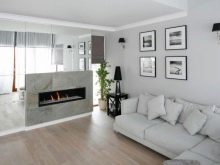
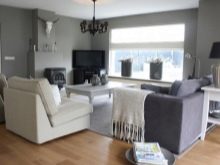

Consider the pros of a living room in gray tones.
- This color is the perfect backdrop for eye-catching, expressive details. It looks great in company with bright accents, balancing them out.
- The interior in this range is not very fashionable. This is a classic version, and you can not be afraid that it will become irrelevant in 2 years.
- It is enough to change the accents in the room, leaving the wallpaper in the same color to change the impression of the composition as a whole.
- The grayish palette, contrary to popular belief, is very comfortable and inviting.
- This range is one of the most noble, status, universal, looks great both in a laconic interior and in a chic one.




Who is it suitable for?
Gray is perceived as a completely neutral tone, so it can be dominant. It is perceived not only as a derivative of black and white, but also as a shadow, a frame... This design is well suited for people with an active lifestyle, business, fast, decisive, those who face stress and risk. The furnishings of such a living room will allow you to relax and unwind.

Comfortable design in grayish tones for conservatives and idealists, those who are entrusted with a lot of responsibility. People striving for excellence feel great in an atmosphere of peace and stability. The predominance of this gamut should be abandoned if there are people in the family who are prone to depressive states, are prone to apathy, lethargy.
It is necessary to include bright cheerful details in the interior.
Gray has always been considered a favorite of aristocrats, people with wealth, who do not need external variegation and unnecessary demonstration. It is possible to choose laconic scales for those who seek to create an elite interior.
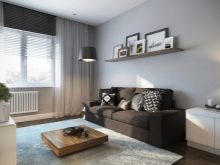


Shades
The gray palette is not monotonous, contrary to popular belief, and it is not always cold, there are warm shades, light, dark, strict and soft. Refined platinum, steel with a blue sheen - colors completely different in mood. At the same time, the cool gamut should be used with care in the interior, even in the loft, hi-tech and industrial styles, as they lower the degree of comfort.
Designers recommend a warm-smoky range of ash, linen, lime, flint, French shade.
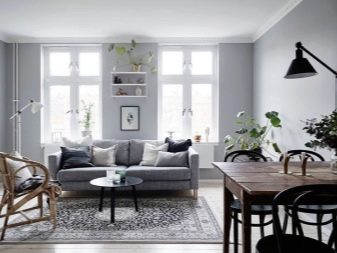



The most popular tones in the interior of living rooms:
- gainsborough - the lightest tone;
- silver - noble and strict;
- platinum - slightly darker than silver;
- gray jacket - warmer, softer;
- nickel - neutral, in good harmony with the warm range;
- cadet - expressive, with the addition of blue;
- Marengo - rich, deep, but not too dark.




In addition, it must be borne in mind that gray itself and all its varieties have shades of light and dark type.
Therefore, the choice of a grayish tone is not an easy, but pleasant task, you can choose the necessary tone for any interior.
Combinations with other colors
The prevailing gray background is a rather controversial decision, it can look too monotonous, boring, uncomfortable. However, it has the right to exist in very large, bright rooms with large windows, ideally panoramic, as a conceptual design option. If the windows are small, then the natural colors behind it are unlikely to be able to revive the room. Even if you prefer gray as the dominant one, you need to think over the accents that will emphasize it favorably, otherwise the interior will seem stingy. Shades of gray, with all their variety, will not help here. If you want to maintain a strict composition, then you can use white and black tones.




With white and black
White and black are ideally combined with grayish shades, they are close in palette, all belong to the classic, perfectly complement each other. You can not be afraid of variegation or vulgarity in such an interior. If you choose the dominant white, with gray and black details, you get a restrained, but light and expressive composition. Light walls, black carpet, gray furniture are an effective solution that can be complemented with a small amount of black accents. Upholstered furniture in gray tones, among other things, is also a very practical option.
In this trio, you cannot leave the main background black, it is better to give preference to snow-white or light gray.



With yellow, red, orange
Since the grayish scale perfectly balances bright colors, you can safely combine the entire yellow palette with it. Such accents will give the ensemble decisiveness, richness, and revive the main gray background. In addition, yellow objects perfectly accentuate grayness.
The same can be said for other vibrant palettes - red and orange. There is a lot of life, light in these tones, they illuminate objects around, making them sound more expressive. In addition, they are warm and increase the degree of comfort in the room. The main condition for such an accent is high-quality lighting and a sense of proportion. You should not place too many bright details in the room, especially when it comes to red, since the abundance of redness can psychologically depress and awaken irritability.



With green
Since the green palette is soothing, natural and calm, it will make a great duet with gray tones. Such a living room will be harmonious, moderately bright and sunny, there will be enough life in it and at the same time noble brevity. In this combination, any of the palettes can be selected as dominant. Grayish details perfectly set off the green background, subtle shades of gray emphasize juicy greenery. Green textiles, paintings, furniture on a gray background look spectacular.
Can be added as an additional or accent piece in brown.

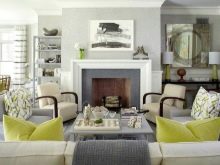

With blue, blue and turquoise
This is a wonderful combination, fresh, original, expressive. You can choose not too complex tones of blue, light blue, juicy turquoise to create a moderately cool and status interior. These shades visually expand the space, have many variations that can be chosen to match almost any shade of gray. An ensemble with a gray brick wall, turquoise details and a blue complementary color will look very expressive. All these tones are in perfect harmony with each other.
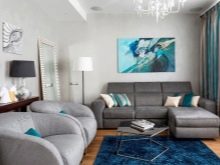

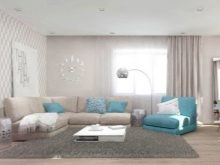
With purple, pink, lilac
This interior is full of mystery, mystery, elegance and grace. However, the shades of purple are very tricky. If you introduce too much purple into the composition, the interior will be depressing. Therefore, it is better to opt for lilac as an additional shade, and consider purple as an accent. The combination of pink and gray can be considered ideal, this is a very sophisticated combination, stylish and delicate at the same time.
Muted pink looks great as a complementary shade



Terms of use
Considering the gray palette when decorating a living room, designers recommend observing some rules:
- appreciate the light, if it is not enough, be sure to dilute the gray with bright and light tones;
- the walls should not be darker than the floor, and the ceiling should not be darker than the walls;
- furniture should not be lighter than walls, but the floor should be darker than furniture;
- to increase the space, to make the room higher, a light ceiling will help - you should not make it gray;
- if the living room is rectangular, use darker shades of gray on the end walls;
- avoid very light floors;
- do not rely on natural light, think over artificial, as the gray scale can dim the light;
- accents liven up, you should not be afraid of them.




Style directions
Gray is acceptable from antique to ultra-modern. The most popular styles in which designers recommend considering a grayish palette:
- underground;

- loft;

- high tech;

- futurism;

- Scandinavian;
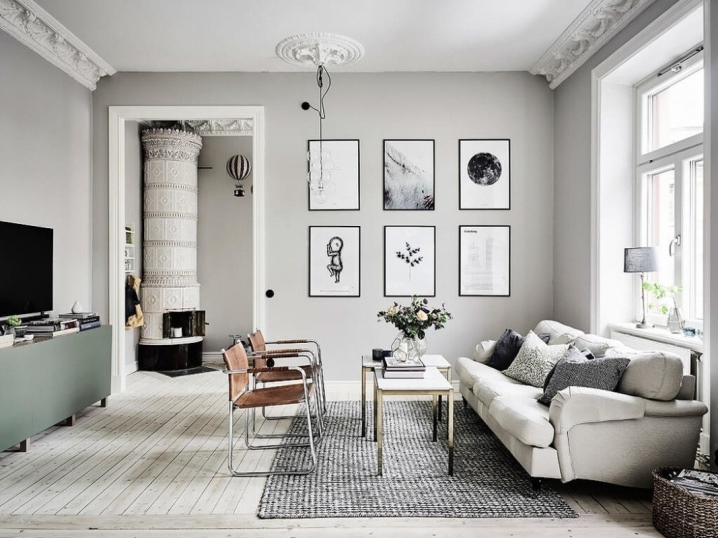
- minimalism;

- Art Deco.

As for the Italian and antique trends, as well as the classics, the gray scale there can be used as halftones, but by no means the main background.
Beautiful examples
- A neutral, barely perceptible shade of a grayish scale looks unobtrusive, it serves as an excellent background for unusual and beautiful accents: paintings, furniture, textiles.

- A very non-standard solution is to decorate the bedroom in deep shades of gray and green. Contrary to expectations, such an interior is not gloomy, noble and status.


- This range is ideal for design in a modern, laconic style. A few bright details are enough to highlight the luxurious simplicity of the gray palette.


- One of the most winning combinations is combining different shades of gray with yellow accents.
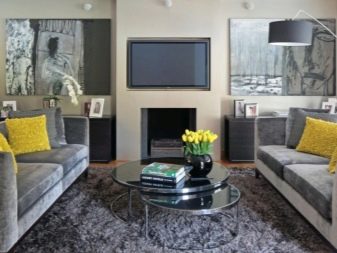

- Calm shades are a great solution for a bedroom, however, so that the composition is not too gloomy and cold, you need to add lemon and other catchy decor items.

- Lovers of the conceptual should refer to the combination of these shades with a red palette. They are perfectly combined with each other, creating a balanced, non-aggressive ensemble.


- If you decide to combine deep, rich tones of gray in the interior, be sure to consider a color that will balance the composition. Ideally, this is the entire gamut of white.

- Another way to effectively liven up a gray ensemble is to add purple tones to it. Even a contrasting blue carpet on the floor looks appropriate here, since the main, dominant gamut is as neutral as possible and allows you to experiment with color.

- Pearl-mother-of-pearl details fit very well into the pale ash interior.


- An austere, minimalist design with understated style can be easily formed by combining tones of gray and brown.















The comment was sent successfully.